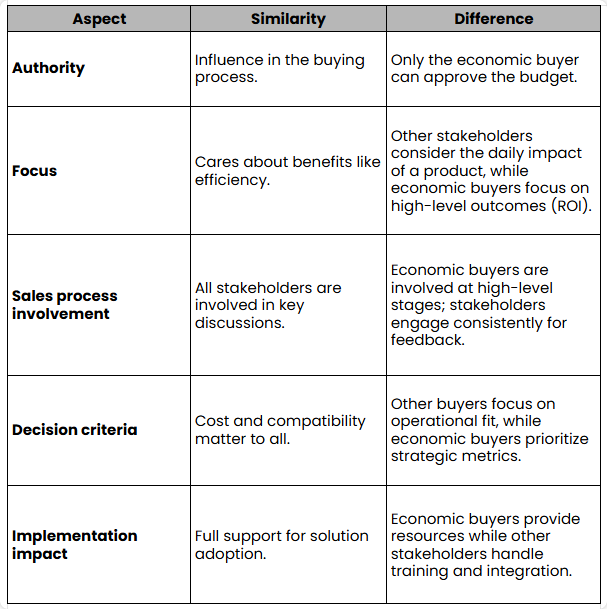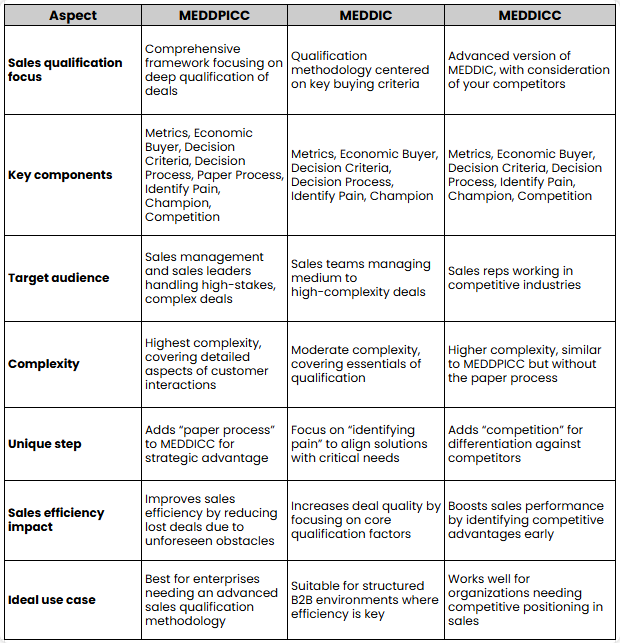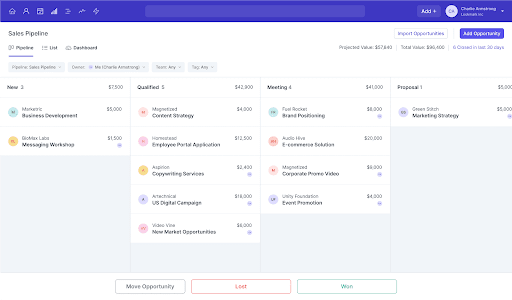In 2025, salespeople will face a new reality: traditional techniques will struggle to cut through. Sales teams must get creative with their techniques, as basic approaches might fall flat.
To succeed, they’ll need strategies with staying power – and MEDDPICC is one of the few methods that consistently works. Today, you’ll discover how MEDDPICC works and why it delivers results.
What is MEDDPICC?
MEDDPICC is a sales qualification framework that identifies the core factors influencing buying decisions, helping sales professionals target high-value opportunities.
With a MEDDPICC sales methodology, reps gain a structured approach to spot critical deal details, such as metrics and key selling drivers. This leads to a stronger foundation for sales success and an improved decision-making process.
MEDDPICC elements
The MEDDPICC methodology covers essential components that guide sales reps in complex enterprise sales environments.

Metrics
In sales strategies, numbers speak louder than words. Metrics reveal your solution's quantifiable benefits to the prospect’s organization, offering a compelling reason to move forward. To find key metrics, ask targeted questions like, “What specific outcomes do I need to achieve?” and “How does this solution align with my performance goals?”.
Knowing these figures will help you frame your solution as a direct answer to the prospect’s measurable needs.
Examples of metrics that drive value for prospects include:
- Revenue growth: Highlight how your solution can increase the prospect’s top-line revenue. For instance, it could be through improved sales conversion rates or new market opportunities.
- Cost reduction: Demonstrate the potential for cost savings like reducing operational costs by automating certain processes or replacing other solutions.
- Productivity gains: Explain how your solution can increase output while reducing task completion time, for example.
Economic buyer
The economic buyer is the person with the power to greenlight your solution: they’re the decision-maker. Finding them early means you can speak directly to their priorities: growth, efficiency, and outcomes that drive the business forward.
When engaging the economic buyer, go beyond features. If they’re focused on increasing team productivity, show how your solution removes bottlenecks, helping the team accomplish more in less time.
The key to understanding the economic buyer is to identify the factors that influence their decision-making. Below are five main points of comparison, outlining the similarities and differences between economic buyers and other stakeholders involved in the sales process.

Decision criteria
What if you could pinpoint the factors driving a prospect’s purchase decision?
Understanding your economic buyer’s decision criteria helps you decide if the lead is a good fit. And if so, you can use it to craft a proposal matching your solution to their specific needs. So try to put yourself in your prospect’s shoes – here are the factors they’re likely to consider:
- Cost-effectiveness. Is the solution within budget, and does it deliver a strong ROI?
- Alignment with strategic goals. Does the solution support the organization's larger goals?
- Ease of implementation. How quickly can the solution be integrated with existing systems?
- Scalability. Can the solution grow with my company, meeting current and future needs?
- User adoption and support. Will the solution be easy for my team to use?
- Risk and compliance. Does the solution meet legal and security requirements?
- Competitive advantage. How does the solution stand out within a competitive landscape?
You should consider these criteria in your sales pitch, including all the critical elements that matter to your prospect's organization.

Decision process
When selling B2B, we can trace the prospect’s steps in the decision process from interest to approval.
Knowing each stage and potential roadblocks gives your sales team a roadmap to keep the process on track and address issues before they become obstacles.
Here’s how each stage unfolds:
- Initial evaluation. The prospect starts by exploring solutions to solve their specific challenges. At this stage, you should provide clear, high-level information that directly addresses their priorities and showcases the unique benefits of your solution.
- Stakeholder involvement. This stage brings in multiple decision-makers from different departments, each with unique requirements. Engage them by addressing specific criteria relevant to their roles, such as budget concerns or operational impact.
- Technical and compliance review. The prospect evaluates how well your solution integrates with their systems and security policies. Have technical documentation and access to demos or sandbox environments ready to address compatibility, performance, and scalability questions.
- Financial approval. Usually, the economic buyer reviews costs and ROI to ensure the solution aligns with the budget and offers clear financial value. Using data-backed metrics that demonstrate ROI will help prove the investment's cost-effectiveness.
- Final decision and sign-off. The economic buyer (or another ultimate decision-maker) evaluates all inputs and gives the final approval. You should summarize the solution’s value, show how it meets each stage’s criteria, and confirm organizational support.
Paper process
The paper process often becomes a bottleneck in closing deals, involving legal and administrative steps that can stall momentum. The more prepared your team is for legal review requirements, the faster the process will move.

An effective way to speed up the paper process is to involve the economic buyer early. Having documents ready and preemptively addressing common legal concerns can also prevent unexpected holdups.
You can also expedite the paper process by communicating directly with the prospect's legal or procurement departments as early as possible.
Imagine you’re about to close a major deal in the healthcare sector. Just as everything’s lined up, the prospect’s team asks for compliance documents that hadn’t come up before. If you’d connected your legal teams at the outset, that last-minute scramble wouldn’t be happening.
In industries where security and compliance are priorities, arranging an early call between legal teams can make all the difference. This simple step brings clarity to everyone involved and heads off last-minute paperwork surprises – keeping the deal on track.
Identify pain
Think of it like a doctor’s appointment. When you visit the doctor, they don’t instantly reach for the prescription pad. First, there’s an assessment: symptoms are discussed, potential issues are explored, and only then a diagnosis is made.
Your potential client needs the same approach. To effectively connect with the prospect, you must identify their unique ‘pain points’ – the business challenges or inefficiencies they’re dealing with – before offering a solution.
Ask questions that explore your prospect's actual challenges. Get a sense of their sales strategy, what’s stalling their sales pipeline, and what’s stopping their sales performance from reaching the next level. Once you know their pain points, you can present your solution as the answer: a solution directly tied to their specific needs.
For example:
- A sales team is struggling with long approval cycles and slow sales.
- A marketing agency may need more efficient lead qualification strategies.
- A small sales team doesn’t clearly understand their sales process.
In each case, knowing these specific pain points lets you show your solution as the exact fix they need, opening the door to a stronger, trust-driven sales conversation.
Champion
A champion is an insider within the prospect’s organization who believes in your solution and has the influence to help it move forward in the prospect's decision-making process.

Who makes a great champion?
- Impact insiders – people who hold respect and influence within the organization, even if they’re not the final decision-makers.
- Strategic stakeholders – team members who understand how your solution can address the company’s challenges.
- Proactive supporters – those willing to champion your solution through each step of the MEDDPICC process, from economic buyer identification to procurement and legal review.
It's not easy to find a champion. Sometimes, champions aren’t present in the sales process at all and you shouldn't force yourself to find one. If the champion lacks influence and doesn’t have the authority to make an impact and empower sales professionals, it’s best to pivot.
When a champion shows low engagement, such as being unresponsive or only mildly interested, they’re unlikely to push the solution forward. If their goals don’t align with your solution, it’s time to look for someone who’s a better fit – or stop looking altogether.
Competition
Knowing where competitors fall short gives you a tactical edge in winning deals. To use this to your advantage, pinpoint exactly where their solutions miss the mark.
Are they slow on support? Do they struggle with adapting to customer needs? Was there a problem with their last system update? Identifying potential weaknesses lets you highlight how your solution excels in these areas.
For example, if a competitor has a complex onboarding process, you can emphasize how your solution integrates smoothly, saving time and resources for the prospect’s team.
Frame these advantages around the prospect’s decision criteria, showing your solution as the answer to issues that competitors leave unresolved.
When you’re clear about these contrasts, engage with key decision-makers by showing them how your solution meets their needs more efficiently. This simple step turns competitor gaps into strengths for your offering, giving the prospect a valid reason to prioritize your solution.
MEDDPICC vs MEDDIC vs MEDDICC
While MEDDPICC, MEDDIC, and MEDDICC might look similar at first glance, each framework brings unique nuances to the sales process. The differences go beyond just an extra letter in the acronym – each framework adds specific steps or focus areas that can shape how you approach a deal.
We've broken down the key distinctions between these methodologies below to help you find the right fit for your sales strategy.

Popular MEDDPICC use cases
Complex B2B sales cycles
MEDDPICC works well in long, multi-stage B2B sales where you need to secure buy-in from multiple stakeholders. For example, selling a CRM system to a large company often involves department heads, IT, and procurement who all need different assurances.
High-value contracts
With MEDDPICC, you can easily demonstrate the strategic advantages of your solution to close high-value contracts faster. For instance, when pitching a data management platform for an enterprise, MEDDPICC guides you to focus on specific financial impacts to the economic buyer.
Competitive environments
In a market filled with countless solutions, MEDDPICC highlights your unique advantages. For example, if you’re selling a cybersecurity solution, use MEDDPICC to point out areas where your services provide more comprehensive coverage than competitors.
Similarly, when partnering with a Hubspot website agency, your ability to tailor website and marketing strategies for clients can become a key differentiator.

Regulated industries
MEDDPICC’s paper process step is indispensable for sectors with strict compliance standards. Selling a patient data platform, for instance, often means meeting legal requirements before approval. This process can be mapped with the help of MEDDPICC.
New solution introductions
MEDDPICC helps engage the right stakeholders and build internal support when introducing a new product. Say you're launching a cloud migration tool and encounter a few obstacles: MEDDPICC can address some of them, such as IT's technical concerns or the CFO's budgetary concerns.
Enterprise-level deals
In complex, large-scale sales, MEDDPICC helps align your solution across departments. For example, selling a large data integration tool may require coordinating with finance, IT, and operations teams. MEDDPICC keeps that focused.
Does MEDDPICC work in all situations?
MEDDPICC isn’t suited for every sales situation.
Its complexity adds little value to simple, transactional sales like office supplies or basic software subscriptions since buyers make quick, low-stakes decisions. In small-scale B2B deals with just a few stakeholders, MEDDPICC can also feel excessive.

For example, in cases where a buyer seeks a short trial or pilot, MEDDPICC may weigh things down. These prospects often explore solutions quickly rather than engage in a comprehensive buying process.
MEDDPICC’s in-depth qualification can be misaligned when the price is the primary factor. For price-sensitive deals, prospects usually prioritize the cost, not the specific value MEDDPICC highlights.
Likewise, in industries like fast-moving consumer goods (FMCG), which rely on high turnover, a simplified, speed-focused sales process is usually more effective. MEDDPICC also doesn’t add much value for one-time purchases where there’s no need for relationship-building or ongoing advocacy.
And finally, if the sale involves limited decision-making layers, such as a basic SaaS add-on to an existing customer, MEDDPICC’s extensive steps may not be necessary as a single point of contact may be all that’s required to move forward.
How CRM can help you in MEDDPICC sales methodology
MEDDPICC is a powerful framework, but it needs the right tool to be fully effective.
Capsule CRM is an essential asset, adding structure to each step and helping your sales team capture every important detail. Capsule’s smart, easy-to-use design organizes your sales process, allowing your team to manage contacts, track pipeline stages, and enrich each prospect profile with valuable data.

For example, Capsule’s sales pipeline feature lets you map MEDDPICC stages directly into your sales process, from identifying key metrics and economic buyers to managing the paper process. With drag-and-drop functionality, sales reps can quickly move prospects through each MEDDPICC step.
The contact management feature enriches profiles by linking documents and social profiles – giving sales reps more info about key stakeholders and their pain points without the extra work or manual data entry.
Task management tools in Capsule allow your team to create tasks for each MEDDPICC component. For example, create reminders for actions like legal reviews and follow-ups with champions.
Tracking your activities in one centralized system provides your team with a clear view of progress and any obstacles in the MEDDPICC process.

Capsule also integrates with other business tools through its app marketplace. You can connect Capsule with platforms like Microsoft 365, Google Workspace, and Mailchimp so your team has everything it needs in one place to implement MEDDPICC on the spot.
MEDDPICC summarized
MEDDPICC transforms complex sales by turning every critical step (metrics, economic buyers, decision processes) into a structured, actionable game plan. It sharpens lead qualification, speeds up the sales cycle, and gives you the clarity to forecast with confidence.
And with Capsule CRM, implementing MEDDPICC is easy. Capsule brings every MEDDPICC element into one powerful, intuitive platform, from tracking decision criteria to mapping out stakeholder interactions. Ready to make MEDDPICC work for you? Get started with Capsule for free, and watch your sales strategy reach new heights.
Frequently Asked Questions
MEDDPICC is a structured framework designed for complex sales environments. It helps sales professionals qualify leads by focusing on key factors within the buying organization, such as success metrics and decision-making processes. This sales framework supports a thorough approach to understanding pain points and driving deals forward with strategic insight.
It depends on your use case. Both MEDDIC and MEDDPICC are effective for complex sales, but MEDDPICC includes additional steps for even deeper qualification, such as the “Paper process” and “Competition”. The MEDDPICC model is ideal for companies needing to incorporate procurement into their sales processes, while the MEDDIC model may work best for less complex B2B sales.
MEDDPICC is a widely used sales framework and doesn’t belong to a specific company.
Various sales training programs and consultants have expanded on the MEDDPICC framework to help sales teams implement it internally and adapt it to their company’s needs for improved efficiency.
MEDDPICC stands for Metrics, Economic buyer, Decision criteria, Decision process, Paper process, Identify pain, Champion, and Competition. Each component represents an action or key component within complex sales environments, helping sales reps align their solutions with prospects' needs and persuade decision-makers.
MEDDPICC provides a structured path for closing complex deals, leading to more sales and fewer lost opportunities. It challenges the notion that flexibility is always key – showing that a disciplined approach can actually speed up the sales cycle and uncover hidden buyer motivations.
In MEDDIC, ‘M’ stands for Metrics, highlighting your solution’s measurable benefits to the prospect. It helps sales reps make a compelling value case by showing how the solution directly impacts critical business outcomes.
Sales reps use MEDDPICC by following each component as a step in the sales process.
From identifying metrics to engaging the economic buyer, MEDDPICC empowers sales teams to qualify leads thoroughly, manage pain points, and address internal steps – e.g., the legal process within the prospect’s organization.
The “Paper process” in MEDDPICC refers to legal and procurement steps for closing a deal. This can include contract reviews, compliance checks, and inside or outside council approval. The paper process ensures that all documentation aligns with the buyer's requirements so the deal is not derailed.




